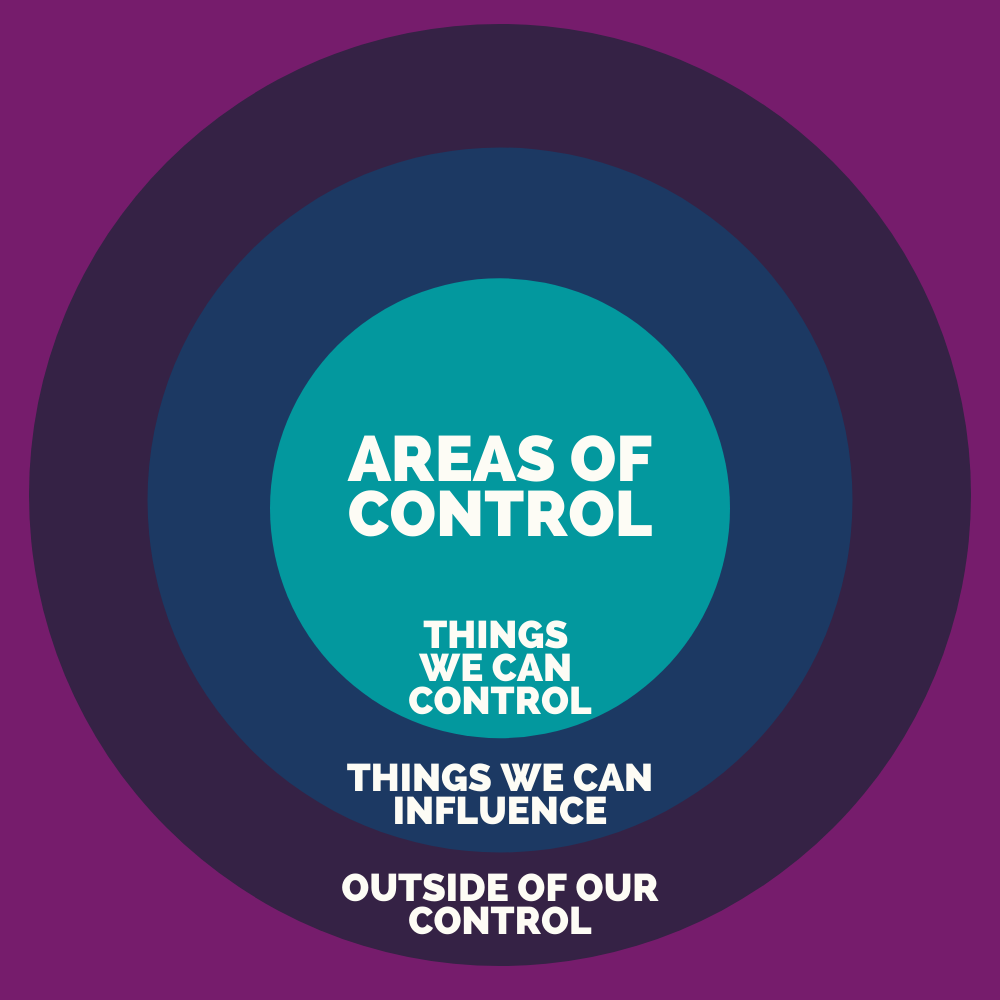Sort Your Stress (Not Your Laundry)
How three piles can help you find some relief during times of stress
Sometimes I get really productive during stress. REALLY productive. It's my coping mechanism and I run around like an energizer bunny, trying to get it all done. But that only lasts a few days before I’m in a heap on the floor, bearing the weight of the world on my mind, wondering why I SUCK AT EVERYTHING and WHY NOTHING IS WORKING. My Inner Monologue truly still believes that if somehow I accomplish every last thing on my To-Do list, then… I'll be okay?
Ugh. THE TO-DO LIST FALLACY. Don’t listen to it. It’s not real. It’s a treadmill and the only way to get off the treadmill is (1) for someone to turn it off, (2) to step off or worse, (3) fall off because you can no longer keep up.
Let’s talk about how to step off the treadmill before the crash.
THE PROBLEM: EVERYTHING IS… A LOT
There’s a lot going on, well, everywhere. From the uncertainty and trepidation from rapid global-political changes, to job losses, to loneliness… it’s everything. People are feeling it in their bodies and struggling to make forward motion.
Here’s why *GESTURES AT EVERYTHING* can turn into feeling like you’re frozen, stuck, or apathetic. This is typically when I start to feel like NOTHING I DO MATTERS and NOTHING WILL CHANGE and I’LL NEVER BE ABLE TO KEEP UP. (The shouting is because this is the way my lizard brain starts to fire when the overwhelm attacks.)
Perceived and real lack of control can lead to real stress, frustration, anxiety, and overwhelm. In psychology, people with less control or agency over their lives can have higher levels of stress and depression. When too much is beyond your control, you might develop anxiety or learned helplessness. Plus there are widespread, systemic cultural factors, institutionalized norms, and historic discrimination that can result in massive power imbalance for various people.
So how do we deal?
There is a simple, powerful coaching exercise that can be radically helpful to transform overwhelm into clarity. It’s a method that can help you re-wire your thoughts, affect your mindset, and help your outlook. And no, this is not going to be ‘just think positive!’ — this is an applied coaching method that helps you regain some of your power, control, and agency.
You’ll need a piece of paper or a journal to do it.
Join me.
RECLAIMING YOUR POWER
Part of the work of being human is reconciling with how much is beyond our control. When we’re faced with news that’s beyond the scope of our capacity to change it, this can result in anger or sadness, but it can also lead to apathy and helplessness.
Especially if you are dealing with long-term stressors that you can’t immediately change, the act of identifying what it is, naming it, and recognizing that it’s beyond your control can still be therapeutic and powerful.
The following exercise is called "Areas of Control,"and if you’re reading this, I highly recommend you get out a piece of paper and write things down for yourself. Give yourself 10-15 minutes. I’ll also walk you through examples to who you how it works.

QUICK PREP WORK
GET A PIECE OF PAPER
Get a piece of paper that's at least A4 size (8.5" x 11") if you can, so you'll have enough space. This exercise is adapted from several coaching practices.
DRAW THREE CIRCLES
Start by drawing three circles, each one a bigger than the next. Give yourself some space for each circle because you'll be drawing inside of it. If you don’t like circles, you can do squares or rectangles, or divide the page into three.
LABEL EACH CIRCLE
The innermost circle = THINGS WITHIN MY CONTROL
The middle circle = THINGS I CAN INFLUENCE
The outermost circle = THINGS OUTSIDE OF MY CONTROL
Below is a visual of the three circles and what they represent. The innermost circle represents what’s within your control, the middle circle is what you can influence, and the outer circle is what’s outside of your control.
AREAS OF CONTROL: THE EXERCISE
1: WRITE DOWN THINGS WITHIN YOUR CONTROL
Begin by listing things that are within your control in the center circle. Anything that you have control over, or that's within your realm of expertise goes here. It does not have to be a complete list, but see how much you can come up with.
Examples: If you get to decide what to eat for dinner, you can choose what time you can go to bed or wake up, you’re able to decide what you can wear, if you’re able to arrive or depart work with flexibility, these are all areas of control. Do you have a door you can close, are you able to walk outside, are you able to decide what to do in the evenings? Add everything you can think of. If you’re able to decide the direction you take at work, the articles you write about, the people you connect with—that’s massive. Keep listing things that are in your court.
Be sure to start with things that you CAN control. This is part of the mental mindset work of the exercise.
Starting with what you can control is part of the power of this exercise. You’re mentally reminding yourself of the agency that you have, and where you can determine things about yourself and your life. So often our minds will dart outwards to the things that are beyond our control, and ruminate intensely on problems. This makes sense—brains like to solve problems. But our minds also like to be reassured by the knowledge that in some areas, we have some agency and power.
Check in with yourself: how does it feel to list these out? For me, I often get a little “happy chicken dance” feeling (is that a thing?) It’s where my chest puffs out, and I happily get to visualize all the things I do have agency over.
“Each time you identify something you can control or influence, you’re pulling agency back to your center. You’re disrupting past thought patterns that can get stuck in an unhelpful loops.”
2: WRITE DOWN THINGS YOU CAN INFLUENCE
Next, begin to list things that you can influence (but not fully control) in the middle circle. Start with things that feel easy to break down. Maybe your roommate or spouse chooses dinner, but you can influence it by making shopping list requests. Maybe you influence what time your family goes to bed, but your kiddos are often rambunctious late into the evening and it can vary by and hour or two.
Examples: I can influence my daily meeting schedules by putting “writing” and “busy” blocks on my calendar so that my meetings are more likely to happen in specific windows. I can influence the number of hours I spend scrolling by putting specific app blockers on my phone.
I can influence my representatives by calling them at a frequency that is sustainable and achievable, and putting that action item on my calendar on a weekly basis. I ask other parents to join a group chat where we text each other if we have to remember anything for the kids that day, so we don’t have to always keep up with every email.
Writing down what you can influence helps you see where you have agency within specific challenging scenarios.
It might seem somewhat simple, but the underlying mindset work is important: each time you write something down and identify something you can influence, you’re pulling your agency back to your center. You’re also disrupting past thought patterns that can get stuck in an unhelpful loops. There s magic in writing things down and seeing them. Instead of letting thoughts run off in a loop that goes from from “Oh no, another problem!” to “And I don’t know what to do!” to “ Shit, this is all so overwhelming!” (which can put us in a space of paralysis and overwhelm), start to identify a problem you have, and write down anything and everything that you have the power to influence.

3: LIST THINGS THAT ARE OUT OF YOUR CONTROL
Next, write down things that are out of your control in the outside circle. Things that are global, that are big, that are unwieldy will often land here. But there can also be pesky, irritating, daily things that ratchet up the overwhelm, too.
The key here is to write down things that are out of control that weigh on you and affect you. This is not a massive list of all the things. Write down what’s most irritating and overwhelming and stressful to YOU.
Examples: Smaller examples that can still cause intense frustration? Think of things like the dog next door that barks uncontrollably in the morning, often waking you up. The loud children who scream outside at the playground in the afternoons, clearly having fun, but also making it challenging to work from home. Or a spouse that doesn’t have a clear end time for work, so you never know what time they will get home.
Bigger things can also feel uncontrollable: An elderly parent or relative that’s on the decline. National or global news that feels alarming or frightening. Job security or safety. Financial security or income changes.
WORKING WITH THIS THIRD LIST
OPTION A. Write it down and put it away.
Checking in: How do you feel with these three lists? What does the last list bring up for you? Sometimes just writing it down can be powerful.
Writing down all of your stressors can itself be a powerful tool for relief. Recognizing all that’s going on that’s beyond your control can help you see your life more clearly. For some people, this last list can become a list that you can contain, put away, or let give yourself some rest from. For others, accepting that these are things that are beyond your control is a powerful enough psychological shift.
But if that doesn’t work for you, and this list is still causing stress, there are other ways to manage and reflect on this list.
OPTION B. Find things you can still influence or control.
Take one of the things on your list that’s outside of your control.
Circle it and draw an arrow back to the “Influence” sphere.
Is there anything you can influence, change, or assert to help you with this specific item? Each time you can find something to influence or control about your stressor, the less weight it might wield.
Some ideas:
While I can't control the outcome of the election, I can pick two things that I can do week over week to support people who are aligned with my views.
If there is an issue or a cause that’s important to me, can I amplify or support people who are working on a larger effort for change?
While I can't control what time the children actually fall asleep, I can put dinner on the table at 6:00 to give us enough time for dinner, bed, and bath.
For some reason the evening bathtime routines are super stressful for me. I think I’ll switch things up and take my own hot bath first, and give the children 30 minutes of screentime. That way I can be more relaxed when I dive into the evening chaos, and I don’t have to worry about getting totally soaked by their antics. I’ll be in my robe! MOM GETS THE HOT WATER FIRST TODAY TEAM.
OPTION C. Understanding, acceptance, and grounding
In some therapeutic styles, a trained professional can help you identify and acknowledge your stressors and help you accept that there are things that you cannot change, while also supporting you in staying aligned and grounded with your values. \
This is not about accepting the person, event, or cause of the stress. It’s also not about teaching yourself to ignore or diminish what’s going on. Here’s an example so you can see the process of acknowledgement—acceptance—commitment:
“My ex creates turmoil and confusion due to their manipulative behaviors, ghosting, and random drop-ins. I have rigorously tried all avenues for change (communication, counseling, courts, boundaries), and I am now working to accept that this behavior will not change. Accepting my circumstances is not the same as accepting the behavior. My acknowledgement is to myself, that I recognize that I am living with something that causes regular negative impacts on my life, and that I often need to do more protective and self-care work to recover from. Because this behavior is not in line with my values, I continue to remind myself that this behavior is unacceptable and that it is also not my fault. In addition, I will commit to doing things that are within my control, like talking to a close friend, venting to a therapist, and taking regular walks to reduce my stress.
RECONNECT WITH YOUR POWER
This mindset exercise is quick, and once you do it, you can use it again and again for different situations and scenarios. By doing it, you are:
EXTERNALIZING: Writing things down, which is a a powerful process for unpacking, slowing your brain loops down, and seeing things in new ways.
REGAINING CONTROL: By starting with a list of things that are within your locus of control, you can expand (or reclaim) your power and agency.
EXPANDING YOUR INFLUENCE: Asking yourself where you have influence expands the amount of power you have, and clarifies what steps you can take.
UNDERSTANDING ACCEPTANCE AS POWER: By acknowledging things beyond your control, identifying how these go against your values, and accepting what’s yours to change (and what is unchanging) you’re bringing the power back to yourself.
The process of writing disrupts our normal mental loops and helps us see things in a new way—literally.
— Sarah K Peck
Leadership ☀︎ Business ☀︎ Parenting ☀︎ Mindset ☀︎ Humor
Startup Parent (Podcast)
Founders With Kids (Community)
Wise Women’s Council (Leadership Incubator)





